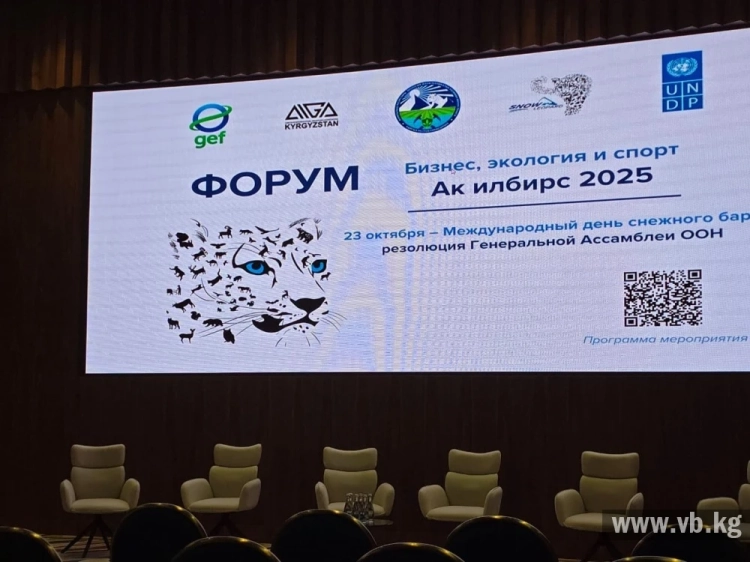On October 22, an international conference dedicated to wildlife conservation and the development...

State Natural National Park "Kyrchin" The State Natural National Park...

Protected Natural Areas of the Kyrgyz Republic “We, the people, will lose part of our essence if...

In recent years, the concept of natural heritage has increasingly entered analytical research and...
The Ministry of Nature reported on the results of raids during which citizens engaged in illegal...

Karakol National Nature Park The park was established in accordance with the Resolution of the...

In 2018, 436 initiatives for nature protection were approved in Kyrgyzstan In the past year, the...

“Sarkent” - an ancient name of a settlement The National Nature Park Sarkent is located in the...
In Bishkek, a forum was held dedicated to the International Snow Leopard Day, which is celebrated...

The Attitude of the Kyrgyz People Towards Their Land An important renewable natural resource since...

The State Nature Reserve "Surma-Tash" inspires with its beauty and uniqueness. The...
On October 23, an international forum titled "Business, Ecology, and Sports — Ak-Irbis...

Categories of Protected Natural Areas in Kyrgyzstan Kyrgyzstan has established 83 special...

All elements and conditions, as well as phenomena and bodies of nature, can be used in public...

In the Talas region of Kyrgyzstan, new methods for protecting biodiversity are being tested:...

In the ridges of the Kyrgyz Ala-Too, there are 480 glaciers. The largest of them are located in...

WELCOME TO THE GUEST HOUSE "KOK-ARCHA" The guest house "Kok-Archa" is located...

The Saymaluu Tash area translates from Kyrgyz as “painted stone” The State Natural National Park...
On October 23, the forum "Business, Ecology, and Sports — Ak-Irbis 2025" was launched in...
A raid was conducted in the Alamedin district, organized by inspectors from the Regional...

Water resources are surface and groundwater that are suitable for use in a given territory. The...

Land resources refer to lands that are systematically used or suitable for use for economic...
A pelican has appeared at the rehabilitation center of the NGO "Bugu-Ene." This was...

As part of the projects approved by the Council for Humanitarian Cooperation of the CIS for 2014,...

“Kulun-Ata” translates from Kyrgyz as “foal of the father.” The Kulunatin State Reserve was...

Kara-Shoro Mineral Waters In the Uzgen district of the Osh region, in order to preserve unique...

A forum titled "Business, Ecology, and Sports – Ak-Irbis 2025" is taking place in...

Increasingly, Western travelers and tourists are seeking exotic vacation spots located "off...

SKRYABIN Alexey Sergeevich...

Ismanov Akhmat Ismanovich (1932), Doctor of Economic Sciences (1990), Professor (1991),...

By the nature of water use, all modern sectors of the economy in the Chui Valley are usually...

State Natural National Park "Salkyn-Tor" - a wonderful place for ecotourism The State...

Kyrgyz-Ata Natural Park is located in the basin of the river of the same name, which flows down...
The Cabinet of Ministers has officially recognized the snow leopard (irbis) as the national symbol...

Dzhamanbaev Akmatbek Sagynovich (1933-1992), Doctor of Technical Sciences (1973), Professor...

Besh-Tash Nature Park is located south of the city of Talas on the northern slopes of the Talas...

Sartbaev Madin Kalkabaevich (1941), Doctor of Technical Sciences (1988), Professor Kazakh. Born in...

Types of Tourism in Kyrgyzstan Based on the diverse tourism resources available in Kyrgyzstan, the...

Tourism in Kyrgyzstan Tourist resources are understood as a set of natural and artificial...

The fauna of the Chui Valley is part of the Western Tienir-Tous zoogeographic region. According to...
In the Issyk-Kul region, an active fight against predators threatening livestock has begun, reports...

The intensive development of industry, transportation, and overpopulation in several areas of the...

It has been noted above that a significant part of the territory of the republic is subject to...

The signal about possible poaching in the Ak-Suu gorge led to the departure of employees from the...

Climatic conditions, along with other factors, determine the characteristics of biological...
According to information from the press service of the Ministry of Emergency Situations (MES), an...

State Natural Park "Chon-Kemin" is a nature conservation and scientific research...

According to their morphometric data and regime, artificial water bodies—reservoirs—are similar to...